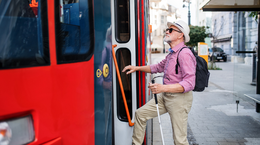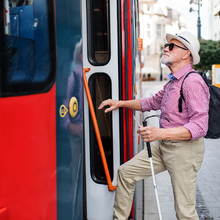Inclusive Journeys
Being able to get around safely is important for everyone, but for people with sight loss some things can make it harder to do this. RNIB campaigns to make our streets and public transport safe and accessible to all.
In this section
Getting Around: What blind and partially sighted people told us
The way people in the UK travel is changing rapidly with more pavement obstacles, reduced bus services, and a rise in e-scooters and e-bikes. For blind and partially sighted people, these changes can be exhausting and dangerous. More than half of people with sight loss tell RNIB they want to go out more than they currently do.
How you can make our streets accessible for everyone
In this guide, you will find out what you can do to support people with sight loss in your neighbourhood and make our streets accessible to everyone.
Seeing streets differently
Welcome to RNIB's guide on how you can make a meaningful impact in the lives of people with sight loss through our Seeing Streets Differently initiative.
RNIB and Motability Foundation partnership
Together, RNIB and the Motability Foundation are leading a bold new initiative to make journeys more accessible for blind and partially sighted people.
Reports and research
RNIB Scotland calls for Street Credibility
RNIB Scotland is delighted to bring you our latest report: Street Credibility: making Scotland’s streets accessible for people with sight loss.
Inclusive Journeys: Improving the accessibility of public transport for people with sight loss
Blind and partially sighted people tell us that better accessibility to transport and public places is the most important factor to improve their quality of life. However, many are not able to make the journeys they want to – 1 in 3 rarely or never use public transport. This limits their ability to work and participate in society.



















